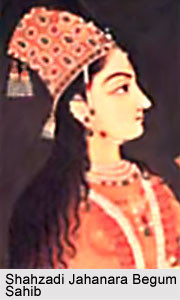As mentioned in a previous blog, Americans fell in love with Princess Jasmine in the Disney animated classic, Aladdin. A princess that was slightly similar to Princess Jasmine actually existed in the history of India, and she became a legacy throughout many events in her life. Her name was Princess Shahzadi Jahanara Begum Sahib, and she was the daughter of the Mughal Emperor Shah Jahan.

Princess Begum was the eldest daughter of Shah Jahan, the emperor who built the Taj Mahal as a tomb and a memoriam to his wife Empress Mumtaz Mahal. After her mother’s death when Jahanara was only 17 years old, she was tasked with taking her mother’s place, until her brother reached an age where he could become the King of the Mughal Empire. Additionally, she took over the job of helping her father overcome depression, which set in after the death of his favorite wife, Empress Mumtaz Mahal. Jahanara Begum was put in charge of arranging her brother’s wedding when he came of age.
Her father adored her and showed her the greatest respect. When her mother’s fortune of 10,000,000 rupees (read rue-pees; this would equal about $160320.70 today), Jahanara was awarded half of the amount, and the rest was split among her younger brothers and sisters. Jahanara had 14 brothers and sisters. Jahanara had a voice in many of his decisions, and was trusted with many duties at a very young age. The emperor repeatedly asked her for advice on ruling the nation, as well as trusted her with the Imperial Seal of the Mughal Empire. Her father also gave her many titles, and her own palace to live in, located near Agra Fort. Her adolescent life was spent with many glories showered upon her by her father.
Jahanara suffered a near death incident after her 30th birthday. Her clothes which were soaked in fragrant smelling oils caught fire, and almost burned her up. Upon hearing this, her father rushed to his daughter’s bedside and helped her recuperate. After the accident, she decided to go on a pilgrimage to the Moinuddin Chishti, (read Mo-u-din chi-stee) shrine in Ajmer (read Ah-j-mear). This shrine was for the patron saint of Sufism, a religion that occurs only on the Indian subcontinent. After she was well again, her dad gave her a reward of rare gems and jewelry, along with the profits brought in from the port of Surat (read Sue-rah-th; a city in the state of Gujrat [read goo-jh-rah-th]).
Once her younger brother, Aurangzeb (read A-roong-zeb) came to power (as women could not ascend the throne as a ruler during that time), he imprisoned both Jahanara, and his father at Agra Fort, which still stands today, because of some familial troubles. Due to her unending devotion for her father, and his old age during his imprisonment, Jahanara became his caretaker until the day he died. However, soon after he died, Jahanara and her younger brother reconciled and she was treated as the First Lady of the empire. As time went on, she started to advice her younger brother on political matters as well, such as his strict rules that the empire’s citizens should abide by his conservative religious beliefs and the restoration of the poll text on non-Muslims. She was able to remove this, by showing him that this would alienate his Hindu followers.
At the end of her life, she lived in her father’s palace, and created many famous structures such as Chandhi Chowk (read Chah-ahd-nee Cha-awk). She also painted, and wrote poetry. Jahanara died on September 6th, 1681 at the age of 67 years old. She was a famous women who had liberties that were not offered to women at that time.


As a fellow Indian, it is always interesting to learn more about the rich history of India! I have always wondered what life would be like if I were in Princess Jahanara’s shoes. She seemed to live a rich, lavish lifestyle, but I never realized the amount of duties she held as a young child. Not only did she have to temporarily take the place of her mother, but she had to help her father overcome depression and arrange her brother’s wedding, which is a lot of responsibility to take on as a teenager. Her strength as a woman is truly inspiring. Thanks for sharing!
Wow! I really liked your blog post! It’s always interesting to learn about the real life figures that inspired such famous movies! Jahanara is a really inspirational person! To be able to defy the norm for women and be able to be someone who can “control/manipulate the laws/events in the shadows” (but of course without the sinister connotations that goes with this phrase) is impressive. She was able to know what she wanted, had a sharp mind, and devotion to both her family and her country. Wow!